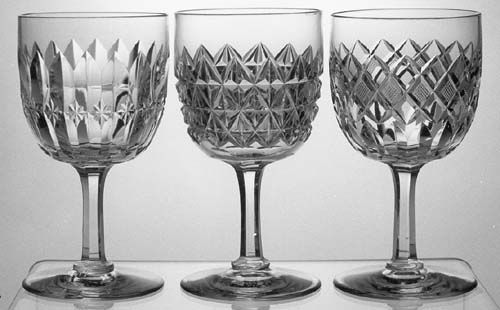
Although ten years have passed since photographs of these six goblets were first published, no progress has been made regarding their identification. They were discovered in a shop in Stonington, CT. It has been assumed that they represent an assortment of patterns that could be obtained from a traveling salesman representing a particular glasshouse or cutting shop late in the nineteenth century; in other words, they are salesmen's samples. As such they would have originally been in possession of a fine jeweler or upscale china-and-glass shop. The quality of the goblets is excellent.
The recent publication of catalogs from Cristalleries du Val Saint-Lambert sparked some hope that the origin of these glasses would be found there. But this is not the case. If not Belgium, then perhaps France? The factory catalogs of St. Louis and Baccarat are possibilities and should be investigated.
At the present time perhaps the best hope of identifying the origin of these goblets is to follow an indirect route: The pattern on the goblet in the second row, on the left, exactly matches that on a pair of gold-colored cologne bottles shown in Wiener and Lipkowitz (1975, p. 156). Unfortunately the manufacturer of the cologne bottles is unknown. Several examples in this book, RARITIES IN AMERICAN CUT GLASS, are now believed to be foreign imports.
There is little to add to the discussion of the goblets. The writer's notes do not mention polish, but he recalls that it is excellent, and does not show the characteristics of an acid dip. The goblet's shape is universal and could have been made by one of several glasshouses, both domestic and foreign. Originally C. Dorflinger & Sons was put forward as a possible source for the blanks used. While there is no evidence that the patterns were cut by Dorflinger, they do have the restraint typical of some of this company's nineteenth century cuttings. Because these were, in turn, influenced by Anglo-Irish designs, a British origin for the goblets is a possibility.
The set of six goblets cut in assorted, unidentified patterns. Date uncertain. H = 5.75" (14.6 cm). The set sold for $500 in 1988.


Reference: [Havens, J. M.], 1988: Some Dorflinger attributions, The Hobstar, Vol. 10, No. 7, pp. 13-15 (Apr).
Updated 20 Jun 2000